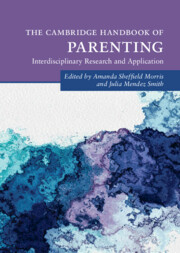Book contents
- The Cambridge Handbook of Parenting
- Cambridge Handbooks in Psychology
- The Cambridge Handbook of Parenting
- Copyright page
- Dedication
- Contents
- Contributors
- Figures
- Tables
- Introduction
- Part I Foundations of Parenting
- Part II Parenting across Development: Social, Emotional, and Cognitive Influences
- Part III Parental Factors That Impact Parenting
- Part IV Child Factors that Impact Parenting
- 17 Parenting Children with Disabilities
- 18 Parenting Children with Externalizing Behavior and ADHD
- 19 Parenting in the Context of Child Anxiety and Depression
- 20 Parenting LGBTQ Children and Adolescents
- 21 Parenting Children with a History of Adversity
- Part V Parent Education, Intervention and Policy
- Index
- References
19 - Parenting in the Context of Child Anxiety and Depression
from Part IV - Child Factors that Impact Parenting
Published online by Cambridge University Press: 01 December 2022
- The Cambridge Handbook of Parenting
- Cambridge Handbooks in Psychology
- The Cambridge Handbook of Parenting
- Copyright page
- Dedication
- Contents
- Contributors
- Figures
- Tables
- Introduction
- Part I Foundations of Parenting
- Part II Parenting across Development: Social, Emotional, and Cognitive Influences
- Part III Parental Factors That Impact Parenting
- Part IV Child Factors that Impact Parenting
- 17 Parenting Children with Disabilities
- 18 Parenting Children with Externalizing Behavior and ADHD
- 19 Parenting in the Context of Child Anxiety and Depression
- 20 Parenting LGBTQ Children and Adolescents
- 21 Parenting Children with a History of Adversity
- Part V Parent Education, Intervention and Policy
- Index
- References
Summary
Parenting is an inherently stressful experience for individuals across sociodemographic backgrounds; parenting in the context of a child anxiety or depressive disorder can exacerbate stress levels. Yet, such effects from child to parent are not unidirectional; there is a strong intergenerational link among anxiety and depression, suggesting a complex interplay of genetic and environmental experiences that contributes to child, parent, and overall family well-being. Few parenting behaviors are uniformly associated with more/fewer internalizing symptoms in children though parent warmth has been negatively associated with anxiety and depression in youth across ages, genders, and cultures (Rothenberg et al., 2020). In contrast, parent psychological control has been consistently associated with greater levels of internalizing symptoms across diverse samples of youth. Given the role of the family in youth anxiety and depression, prevention and intervention programs have integrated parents in a variety of ways with mixed results. Future work that examines the complex interplay of child, parent, family, and broader cultural variables using increasingly sophisticated methodological and statistical approaches is needed to move the field forward in substantive ways.
- Type
- Chapter
- Information
- The Cambridge Handbook of Parenting , pp. 425 - 445Publisher: Cambridge University PressPrint publication year: 2022
References
- 1
- Cited by

